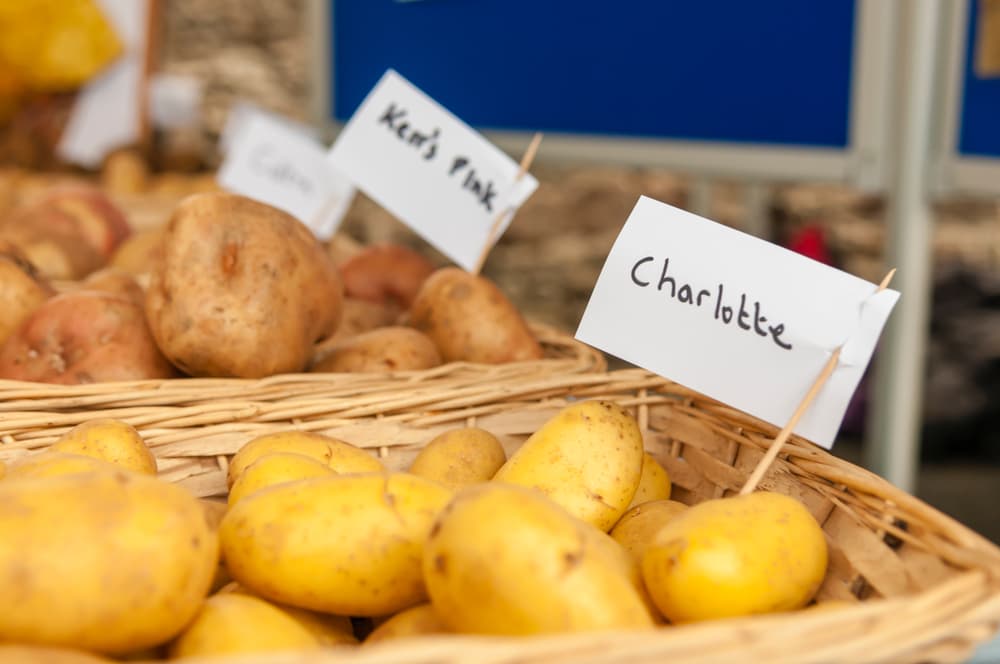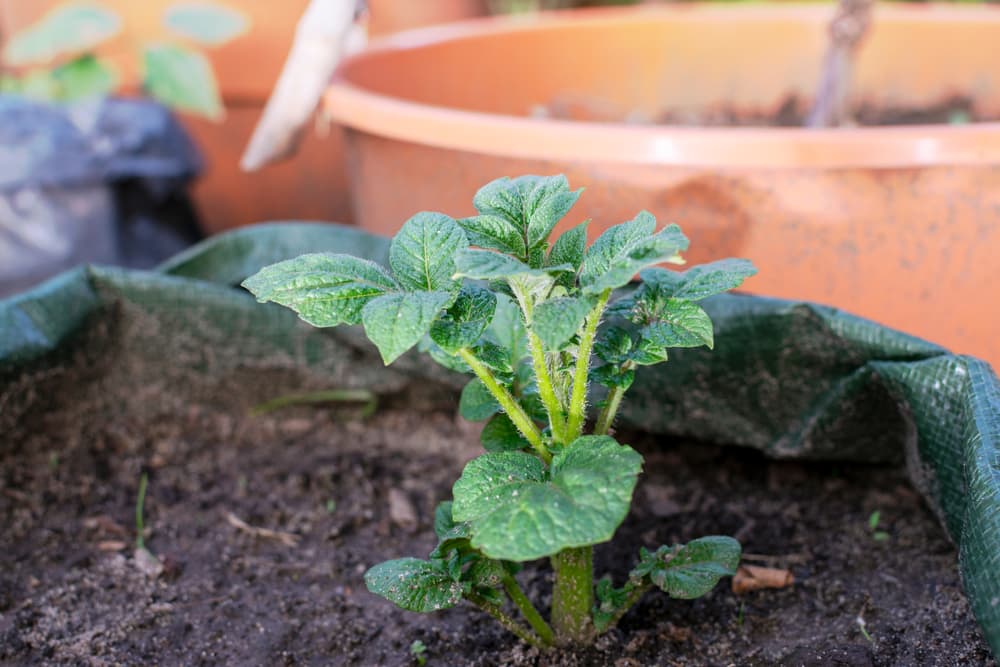VEGETABLES > POTATOES > CONTAINERS

Elizabeth is a Permaculture Garden Designer, Sustainability Consultant and Professional Writer, working as an advocate for positive change. She graduated from the University of St. Andrews with an MA in English and Philosophy and obtained a Diploma in Applied Permaculture Design from the Permaculture Association.
Reviewed By COLIN SKELLY

Colin is a Horticulturist and Horticultural Consultant with experience in a range of practical and managerial roles across heritage, commercial and public horticulture. He holds the Royal Horticultural Society’s Master of Horticulture award and has a particular interest in horticultural ecology and naturalistic planting for habitat and climate resilience.
IN THIS GUIDE
POTATO GUIDES
Container Growing
Desiree Potatoes
Growing From Store Bought
Growing In Grow Bags
Potato Blight
Storage
Sweet Potatoes
Winter Cropping
If you grow potatoes in a pot, you can grow your own even in the smallest of spaces.
Potatoes are one of the common crops that can take up rather a lot of space in a vegetable garden.
Thankfully, it is possible to grow potatoes in much less space.
In this article, we’ll talk about how to grow potatoes in a pot or other container – something anyone can do cheaply and easily here in the UK.
1) Choosing A Potato Variety

The first thing to think about if you want to grow potatoes in a pot is what variety or varieties of potatoes you would like to grow.
Potatoes are usually divided into first early, second early, and maincrop – distinctions based on how long the potatoes are left in the ground and when they are harvested.
First early and second early varieties are generally the best options for growing in containers, because they are harvested when they are smaller, after a shorter time period.
Though it is also possible to grow maincrop potatoes in containers if you choose containers that are large enough.

First earlies are usually harvested from around ten weeks from planting, second earlies from around 14 weeks, and maincrop after 20 weeks or longer.
In addition to thinking about which type of potato to choose, you also need to think about the variety.
You should consider the potatoes you like to eat, and how you like to cook them.
Some varieties are better for mash, some for boiling, some for baking or for frying etc… Some potatoes are floury, while some are smoother and more waxy in texture.

Personally I like the first early potatoes ‘Swift’ and have obtained good yields when growing them in containers.
I have also found second earlies ‘Maris Peer’ and ‘Charlotte’ to grow well in containers where I live.
It is best to purchase certified seed potatoes that are disease-free.1Springborn, F., & Jean, M. (2017, March 22). Planting disease-free potato seed is important for all potato growers. MSU Extension. Retrieved March 23, 2023, from https://www.canr.msu.edu/news/planting_disease_free_potato_seeds
However, you can also plant potatoes you have purchased, or even scraps from those potatoes if they are sections that have the little dimples called ‘eyes’.
2) Start By Chitting Potatoes

Regardless of whether you are growing first earlies, second earlies or maincrop potatoes, seed potatoes are usually planted between March and May.
(Where I live, I plant first earlies in containers in my polytunnel in March, but wait a month or more before planting up containers that will be outside.)
But for best results, it can be a good idea to ‘chit’ your potatoes before you plant them.
This just means that you place your potatoes in a cool but light place indoors to develop green shoots before you plant them.
This is not absolutely essential, but doing so can give your potato plants a bit of a head start and mean a slightly earlier harvest.2Chitting potatoes – Thrive. (n.d.). Thrive. Retrieved March 23, 2023, from https://www.thrive.org.uk/get-gardening/chitting-potatoes
3) Choosing A Container

Once you have chosen your potatoes (and started to chit them if you choose to do so) you should turn your attention to your choice of container.
You can grow potatoes in many different types of container – from plastic pots, to grow bags, to buckets, to wire cylinders or reclaimed wood frames filled to make structures called ‘potato towers’.
It has to be said that the best yields are obtained from mulched raised beds, so if you can grow them in this way – do.
However, if you don’t have much space, container growing can still give worthwhile yields.
Generally speaking, you can plant one seed potato and grow one potato plant in a 20-litre pot, or a container of comparable size.

For first earlies and second earlies you can get away with using a 10-litre pot per plant, but a 20-litre container is better.
If using a larger container, make sure that you allow around 10 litres of capacity per seed potato.
So in a typical 40-litre bin, for example, you could plant 4 seed potatoes.
This is a rough rule of thumb, but can help you avoid overcrowding your plants in whatever container you choose.
Another important thing to think about is that there should be adequate drainage at the base of the container you choose so excess water can drain out of it.

And remember, potatoes are a cool-season crop that needs plenty of moisture.
It is best not to use black or dark containers as these can retain more heat and tend to dry out more quickly.
4) Filling Your Container & Planting Your Potatoes

Planting potatoes is a little different than potting up other plants.
Rather than filling your containers and then planting in the top, you will actually only fill the bottom 10cm or so with your growing medium.
You will then plant your seed potatoes (with green shoots pointing upwards) and cover them with some more of the growing medium.
At this point, your container will be less than half full – this is to allow space for ‘earthing up’.

As the plants grow, you will slowly add more growing medium around the plants until your container is full and the plants are growing strong.
This is to allow more roots and tubers to form from the stem that is covered up.
I have used the term ‘growing medium’ rather than saying soil or compost because you have a few options when it comes to what you plant your potatoes in, and what you use when ‘earthing up’.
To save on bought potting mix or compost, it is always a good idea in an organic garden to make your own.
I make my own compost, and combine this with 1/3 loamy soil and 1/3 leaf mould.
I find that this makes an excellent potting mix for potatoes and a number of other edible crops.

I also add one other ingredient when I am planting my potatoes – after adding the first layer of compost mix, I layer in some comfrey leaves.
Comfrey is a great plant to have in your garden. It makes great mulch, and you can use it to make a liquid feed too.

These leaves break down pretty quickly and give the potatoes a great start.
If you live near a coast, I also find that layering seaweed into the container when planting also works well.
You can also make a mini ‘lasagna garden’ in a container to grow potatoes.
Rather than using ready-made compost, you can layer carbon-rich brown materials (straw, autumn leaves, shredded untreated cardboard) and green materials (nitrogen-rich grass clippings, vegetable scraps etc.).

These layers will break down and compost in place as the potato plants grow and the tubers form.
You are pretty much growing potatoes in a compost bin.
As long as you keep layering a good variety of materials, potato plants should grow well.
Potatoes are not too fussy about what they grow in, so you can use pretty much whatever you have to hand, from your own garden soil, to homemade compost, to organic, compostable materials and they should grow pretty well.
5) Caring For Potato Plants In Pots

As with many plants grown in containers, watering is important.
Potatoes will need plenty of moisture, and those grown in pots will typically need more than those growing in the ground – don’t let the pots or containers dry out.
“I’ve found that keeping potatoes in pots sufficiently watered is the biggest challenge,” shares Colin Skelly, a Horticultural Consultant.
“For the tubers to swell and produce a crop of good-sized potatoes you need to ensure that the growing medium is moist from top to bottom.
“Otherwise, the result can be seemingly abundant and healthy foliage but few and/or tiny potatoes.”
It is also a good idea, for best results, to feed your potatoes once or twice with a good quality organic plant feed.

A compost tea, or seaweed feed are both excellent options (and you can even make them at home).
It can be difficult to tell from your potato plants when the tubers are ready to harvest.
While often, the first tubers will be ready when the first flowers appear, some plants won’t flower at all.
So it is best to simply gently feel in the soil around your plants to see how big the tubers are.
If they are large enough to be worthwhile, you can harvest a few at a time by feeling around, or you can simply upend the whole container and see what it contains.
You might not get the hugest of harvests when you grow potatoes in pots, but they’ll taste so much better when you grow them yourself!
References
- 1Springborn, F., & Jean, M. (2017, March 22). Planting disease-free potato seed is important for all potato growers. MSU Extension. Retrieved March 23, 2023, from https://www.canr.msu.edu/news/planting_disease_free_potato_seeds
- 2Chitting potatoes – Thrive. (n.d.). Thrive. Retrieved March 23, 2023, from https://www.thrive.org.uk/get-gardening/chitting-potatoes

